Self-Guided Prague Walking Tour: One Day in Prague
Prague, the capital city of Czechia, or the Czech Republic, is a popular destination for travelers worldwide. Known for its stunning architecture, rich history, and vibrant culture, it is a city with something for everyone. Walk through its millennial history with this self-guided free Prague walking tour I perfected myself.
I studied in Prague for four years and would occasionally get family and friends visiting me. Therefore, I would always play a tour guide, showing them the best the city offers. Over time, I perfected the route to enable you to see the most iconic Prague landmarks within a day, leaving more time to enjoy other things such as shopping, nightlife, visiting its fascinating museums, or going on day trips, to name just a few. However, if you have more time, here’s your two-day itinerary for Prague to take it slower.
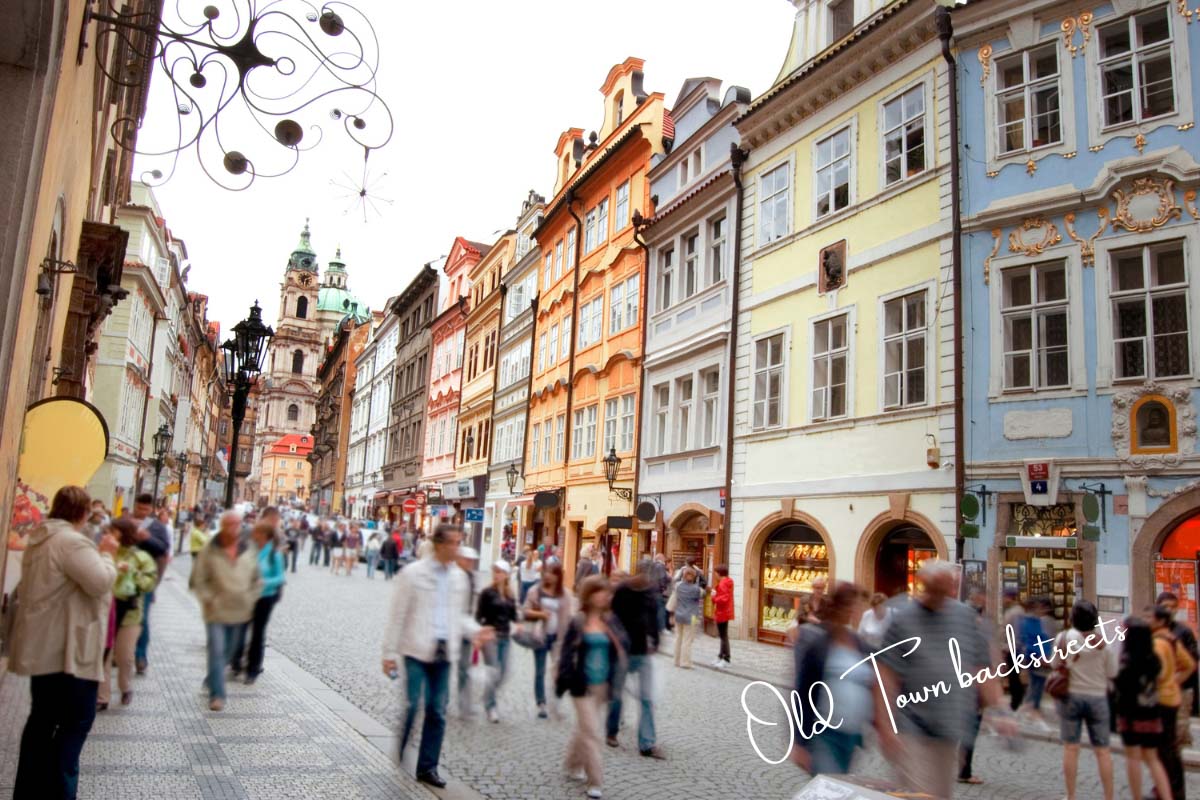
This Prague self-guided and free walking tour starts from Wenceslas Square, goes to Prague Castle by crossing the Charles Bridge, and returns to Old Town Square through the other side of the Lesser Town. The free tour takes you through the city’s major landmarks, public buildings, cultural venues, and places of worship.
This walking tour covers approximately 8-9 km of distance. You can easily make it your one-day Prague itinerary depending on when you start, your pace, and how long you stay in each location. The tour is flexible, so feel free to take a break or omit things that are of no interest to you.
Besides providing the route of the best Prague walking tour, this post also covers accommodation, the best time to visit Prague, and what to pack when planning your trip here. And if you prefer guided walking tours instead of this self-guided Prague tour, I list a few of my recommendations below, too.
Prague Travel Essentials
Get an eVisa: Check if you need one at iVisa and fill out the form to get your eVisa easily.
Book a flight: I use Skyscanner or WayAway. The latter also offers cashback with its Plus membership. Read more here.
Airport transfers: If you want to avoid hassles through public transport, book a private transfer with Welcome Pickups.
Reserve a hotel: I use Booking.com to book my hotels or apartments.
Find best-suited tours: book your activities on Viator or Get Your Guide.
Rent a car: DiscoverCars is one of the best car rental aggregators with a wide choice of vehicles.
eSIM: I use Airalo eSIM whenever I travel. Get 3 USD with code: BAIA2592.
Travel insurance: SafetyWing is my go-to travel insurance covering COVID. Now, they have add-ons for adventure sports coverage and electronics theft.
Disclaimer
This post includes affiliate links to products, which earn me a small commission at no extra cost to you. This helps to fund my blog and bring more authentic articles to you 🙂 Learn more
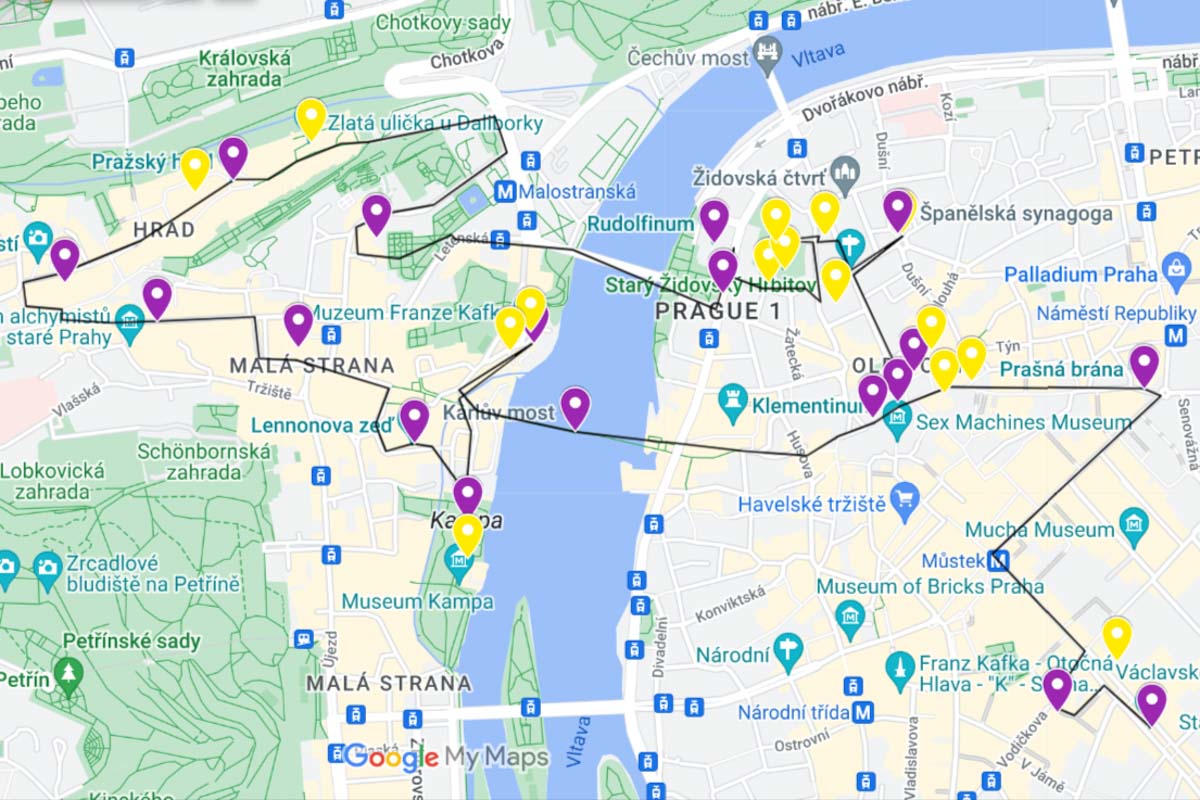
Prague walking tour map
For a more comfortable way of exploring the city and following directions, I have created a Prague walking tour map on Google Maps to save and use whenever you need it. The purple pins on the map mark the main stops on the walking tour, while the yellow pins are the significant locations that I explain within a territory.
Self-guided Prague walking tour
Wenceslas Square
Václavské náměstí, or Wenceslas Square, is one of the main areas of Prague and a place for many locals to meet. It has also been a landmark of many historical events, such as demonstrations, celebrations, and other public gatherings. Named after Saint Wenceslas, Bohemia’s patron saint, the area is more of a 750-meter boulevard than a square.

Charles IV first created it in the mid-14th century as a horse market in the New Town. Today, the St. Wenceslas Monument sits on top of the boulevard with the National Muzeum on its background.
Even though the square is old, the buildings lining up its street are not. The oldest dates back to the 18th century, and the others are much younger. Here, you’ll find gorgeous buildings of Art-Nouveau, Neo-Renaissance, Socialist Realism, and ultra-modernism buildings.
The square is also home to various hops, arcades, clubs, and theaters built during the early 20th-century commercial boom. While walking down towards Old Town Square, pay attention to Wiehl House and the Grand Hotel Europa for their impressive facades.
Upside-Down Statue of St. Wenceslas
The Art Deco-style Lucerna Palace hides a rather interesting sculpture of St. Wenceslas. Called King Wenceslas Riding on a Dead Horse, the monument is the work of the famous Czech sculptor David Černý. Some consider it a parody of a statue in front of the National Museum, but for some, it is an attack on Vaclav Klaus, President of the Czech Republic.
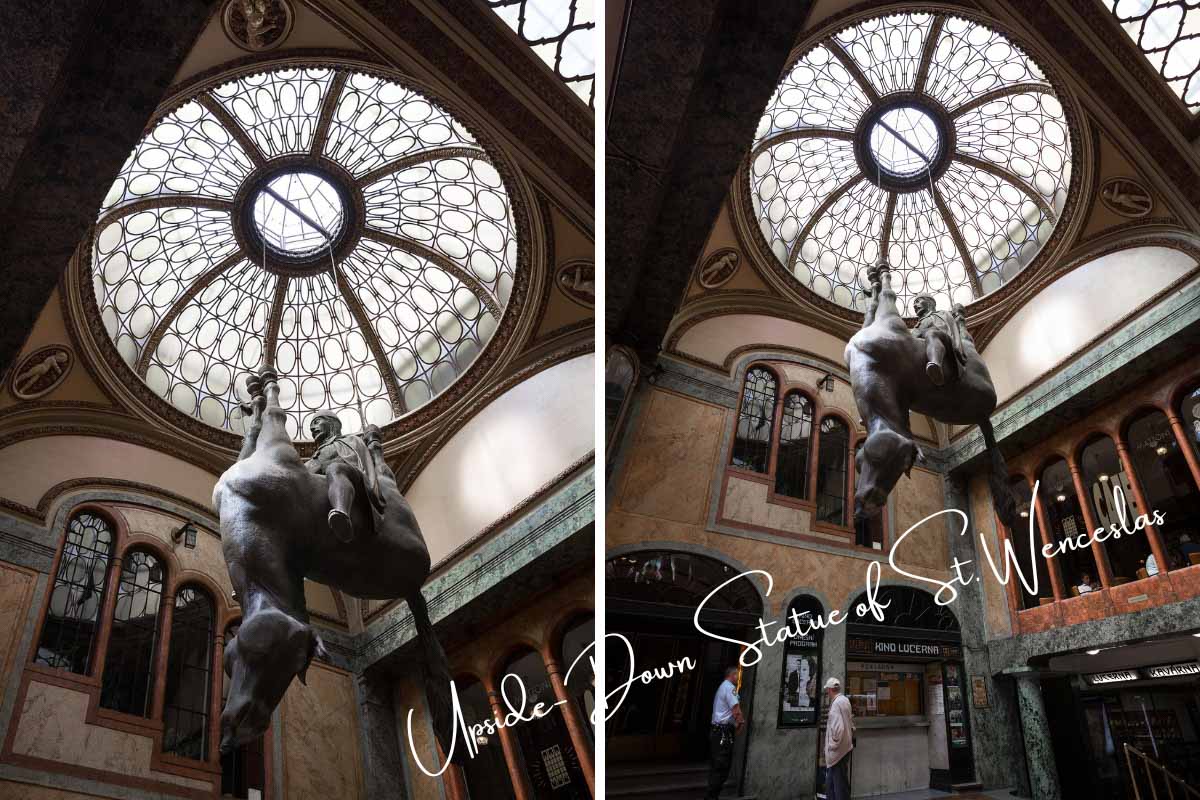
However, Černý never comments on this work; he does not need to honestly. If you see something extraordinary on your trip to Prague, like an old Soviet tank painted in pink floating on the Vltava, then you are a witness of Černys, another creation. Some of his other permanent art is also included in this walking tour of Prague.
Recommended tours in Prague:
The Powder Tower
Once you finish walking down Wenceslas Square, turn to Na Prikope Street to walk to the Powder Tower or Prašná Brána. This imposing Gothic tower is one of the original city gates out of 13. It was intended to be a nice-looking city entrance as an alternative to a defensive tower. The name comes from when the city initials used it to store gunpowder.
It was also used for the coronation ceremonies, during which the Kings of Prague would walk through it and follow the streets leading to Prague Castle. It was rebuilt in the 19th century after being destroyed during the Prussian siege 1757.
If you are up for a walk on a few dozen narrow stairs, you can go up on its viewing deck for some spectacular city views.
Right behind the tower is a breathtaking Municipal Hall to check out. And if you fancy a classical music concert, you can attend one here.
Astronomical Clock
From the Powder Tower, continue your walk on Celetná Street, one of the oldest streets in Prague, leading to the Old Town Square, or Staroměstské námesti. We’ll come back to the area at the end of this Prague walking tour, so instead, continue walking until you reach the Astronomical Clock.

Orloj, in Czech, is a medieval clock installed in 1410. It is considered the third oldest clock in the world and the oldest one that still works. The clock, built by Mikuláš Kadaň, a clockmaker, and Jan Šindel, an astronomer, attracts hundreds of tourists each hour (from 9 am to 11 pm) to watch a marvelous mechanical performance of 12 apostles greeting the city, a skeleton ringing a bell, a miser with a purse full of money, a Turk shaking his head, and Vanity looking in a mirror.
While looking at the clock, you can see the movement of the sun and moon through the signs of the Zodiac. It also tracks Sidereal time, Central European, and Babylonian times.
If you want to go inside the oldest town hall and see the Gothic chapel and staterooms, go down to the underground, and inner mechanism of the astronomical clock, you should book this tour.
House of the Minute
The House at the Minute is next to the Astronomical Clock as you walk on the Karlova Steet.

One of the undoubtedly impressive houses, it was initially a late Gothic building of the 15th century that was renovated into a Renaissance style in the mid-16th century.
White sgraffito (imprints scored on a flat plaster wall to make a three-dimensional effect of depth and shade) decorations on the black background are pretty impressive and tell the story of the Habsburg rulers and scenes from Greek mythology. It also references Renaissance and biblical legends.
Charles Bridge
This self-guided free Prague walking tour continues through Karlova Street again to reach the most famous and spectacular bridges I’ve seen – Karlov Most or Charles Bridge.

After floods washed away a few wooden and the first stone bridges, Charles IV decided to commission a new one in 1357. A 621-meter-long pedestrian Gothic bridge was the only means to cross the Vltava River until 1841; therefore, it was significant in connecting Prague Castle with the Old Town.
Guarded by three towers, the bridge boasts 30 statues and statuaries, primarily made in Baroque and Gothic styles. For spectacular views of each side of the bridge, you can walk up the stairs of the towers.
The bridge is a top-rated Prague attraction that brings many tourists, local musicians, and souvenir sellers throughout the day. It is equally beautiful both in the morning at sunrise and in the evening at sunset.
Urinating sculpture
If you love the artwork, I have included a few stops along this free walking tour in Prague, and the next stop is another impressive sculpture by David Cerny. He is known for creating eye-catching, highly controversial, and humorous artwork.

The Piss sculpture, close to the Franz Kafka museum, features two mechanical naked men taking a poss into a pool that resembles the shape of the Czech Republic. It indeed is one of the quirkiest yet thought-provoking attractions in Prague.
Once you are here, remember to walk Prague’s narrowest alley between two buildings. It has a traffic light indicating when you can walk through.
Kampa Island with crawling babies
Kampa Island was one of my favorite places to walk around when I was in the neighborhood. It is the largest of the Vltava’s islands, featuring cafés, a serene riverside park, old mills, and a playground. I would bring a blanket and enjoy a peaceful time reading a book, studying, or simply relaxing and watching people walk by.

The iconic sight of Kampa Park is another masterpiece of David Cerny – three giant and faceless crawling babies you can climb on and take photos of. They are part of Cerny’s “Babies” project, another excellent example of them as they crawl up the Zizkov TV Tower. So, if you have time on your Prague itinerary, I recommend seeing it, too.
Lennon Wall
Any guided or free walking tour in Prague is incomplete without visiting John Lennon’s Wall, a manifestation of freedom, peace, and love. The wall has different lyrics of Beatles songs or other forms of graffiti, making it an attractive spot for visitors.

The whole concept started in 1988 by youngsters to demonstrate their thoughts about the communist regime. The authorities repainted the wall; however, the activists did not back down and redrew poems the next day.
The wall always experiences change, and the original portrait of Lennon is long lost. However, it contains various tags, writings, or drawings. And if you bring a marker, you can also put something on the wall.
St. Nicholas Church
A Baroque church built between 1704 and 1755, St. Nicholas Church is a stunning place of worship and one of the must-visit attractions in Prague.

Inspired by the chapel of St. Louis-des-Invalides in Paris, the church’s interior is breathtaking, while its characteristic giant green dome and tower dominating the skyline are visible from afar. You’ll see beautiful frescos on its ceiling showing biblical scenes.
Nerudova Street
After a visit to the church, continue your way via narrow Nerudova Street, which is lined with many colorful houses and eventually leads to Prague Castle.
Named after Czech author Jan Neruda, his birthplace and a scene of many of his stories, the street was the final stretch of the Royal Route when the kings walked on their procession to being coronated at the castle.

What distinguishes Nerudova is that the buildings here have emblems to differentiate them from each other before the street numbers were introduced to the city.
As you walk up, make sure you look at the following houses: the Red Eagle at No. 6, the House of the Red Lamb at No. 11, the Three Fiddles at No. 12, the Golden Horseshoe at No. 34, the Green Lobster at No. 43, and the White Swan at No. 49.
Have your eyes pierced for a few stunning Baroque buildings at No.5 and 20, while further up at No.33 is a Rococo house.
Schwarzenberg Palace
The next stop on this Prague free walking tour is the most distinctive Schwarzenberg Palace on Hradčany Square. The sgraffito on the surface makes this Renaissance palace easy to notice.
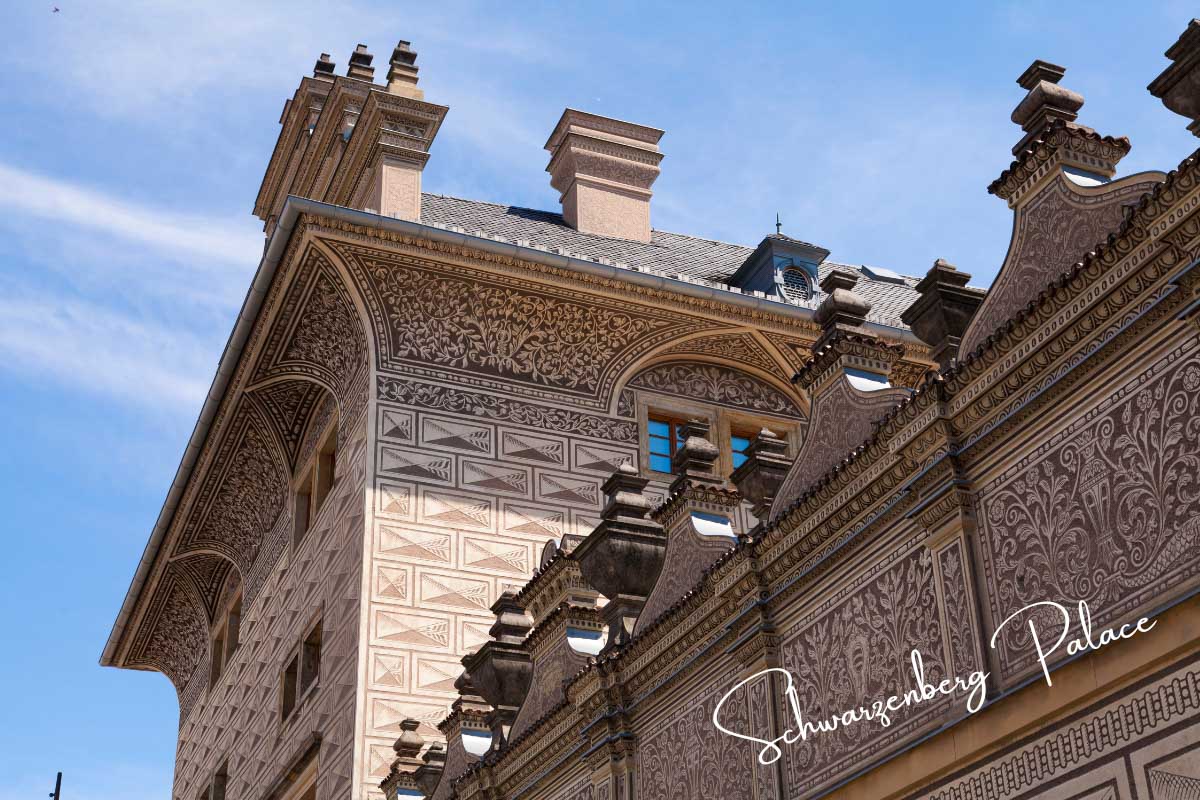
An Italian architect built it for the Lobkowicz Family in the mid-1500s in Florentine style. The Schwarzenbergs, the leading family in the Habsburg Empire, acquired the palace by marriage in 1719. Today, it houses the National Gallery’s exhibition of Baroque art.
Prague Castle Complex
Perched on top of Castle Hill, the stunning Pražský hrad, or Prague Castle, dominates the skyline like no other building. It is the largest coherent castle complex in the world, covering an area of almost 70,000 sq. meters.
The complex, enlisted as a UNESCO World Heritage Site, features large-scale palaces and ecclesiastical buildings, including four palaces, four churches, marvelous gardens, and a defensive tower, all done in different architectural styles.

By the beginning of the 14th century, the complex was home to the royal palace, churches, and a monastery. Reconstructed during the rule of Charles IV, it was destroyed by fire in 1541, and later, most of the buildings were renovated in Renaissance style. Since 1918, the castle has been the residence of the President of Czechia.
You can wander the castle grounds free from 6 am to 10 pm, but many landmarks have different opening hours, and some require an entrance ticket.
Please note that I deliberately haven’t included the most important buildings of the Prague Castle complex as separate listings in this post. Instead, I briefly explain their significance here and have included them as different spots for easy navigation in the Prague walking tour map provided above.
The Gothic St. Vitus Cathedral is the prominent landmark of the castle that used to be a place for kings’ coronations and is also home to the Bohemian Crown Jewels hidden in a dedicated room. Another noteworthy spot here is the St. George’s Basilica, founded in the early 10th century and believed to be the oldest surviving church in Prague. Its red Baroque facade makes it easy to recognize.
Besides, the complex boasts a unique small street called Golden Lane, a collection of colorfully painted historical buildings. Despite its name, don’t expect to find gold-plated pavements or golden decorations here. It got its name after a goldsmith moved into one of the houses in the 17th century.
The lane was also home to Franz Kafka’s sister, who rented house No.22 in 1916, which Kafka himself used for one year to write one of his books. Nobel prize-winning poet Jaroslav Seifert also lived on Golden Lane in 1984.
Today, these houses are turned into shops and a museum displaying medieval armory, clothing, and torture devices.
I suggest spending a reasonable amount of time exploring the complex grounds and enjoying panoramic city views from several viewpoints. Alternatively, you can join the Castle Tour with a Local Guide and Entry Ticket or the Prague Castle 2.5-Hour Tour, Including an Admission Ticket, to see everything and learn more about the castle grounds.
Wallenstein Palace & Gardens
The Wallenstein Palace, one of Prague’s first and largest Baroque palaces, is an ambitious project of the military commander Albrecht von Wallenstein, who decided to build the palace in 1642 to overshadow other landmarks, including the Prague Castle to show his status as a commander of the Imperial Catholic armies during the Thirty Years’ War.

To fulfill the project, he had to buy, destroy, and confiscate a brick kiln factory, three gardens, and many residential houses in the densely populated Lesser Town to give space for his palace.
Nevertheless, it is absolutely stunning once you walk through the palace garden featuring monumental statues and fountains. It is wonderful during spring and summer when flowers bloom.
- Opening hours: the palace garden is open from April to October. Mon-Fri from 7 am to 7 pm and Sat-Sun from 9 am to 7 pm. The palace is open on Saturdays only from April to October from 9 am to 4 pm.
- Entrance fee: FREE for both the garden and the palace.
Rudolfinum
When done exploring the palace gardens, walk towards the Manes Bridge to cross it and slowly go back to the Old Town. One of the first buildings you’ll notice after the bridge is Rudolfinum – one of the most important buildings with several concert halls and home to the Czech Philharmonic Orchestra. This late 19th-century building hosts various concerts, including the Prague Spring International Music Festival.
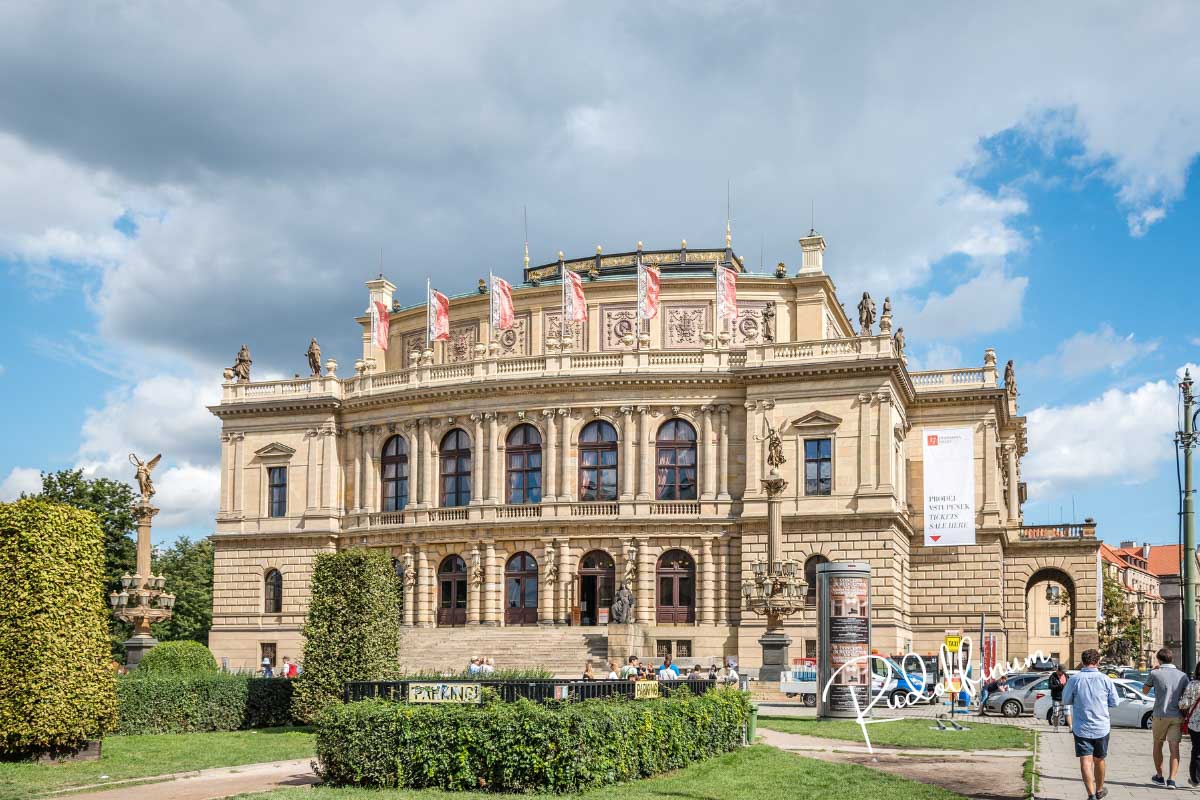
One interesting fact about Rudolfinum is that from 1918 to 1939, and a short period after WWII, it housed the parliament of Czechoslovakia.
Josefov – Jewish Quarter
The former Jewish ghetto of Prague, Josefov, lies in Old Town. Besides being a reminder of the sad past, it actually is one of the upscale areas of the city, with Parizska Street having the most fashionable designer stores.
The Quarter has six synagogues, a ceremonial hall, and an old cemetery. All of the landmarks of the area are within a few minutes walk from each other, enabling you to easily walk around to visit the museums or admire the beautiful architecture of these synagogues. Surprisingly, the area even survived the Nazi occupation as Hitler himself decided to save it as a “Museum of an Extinct Race.”
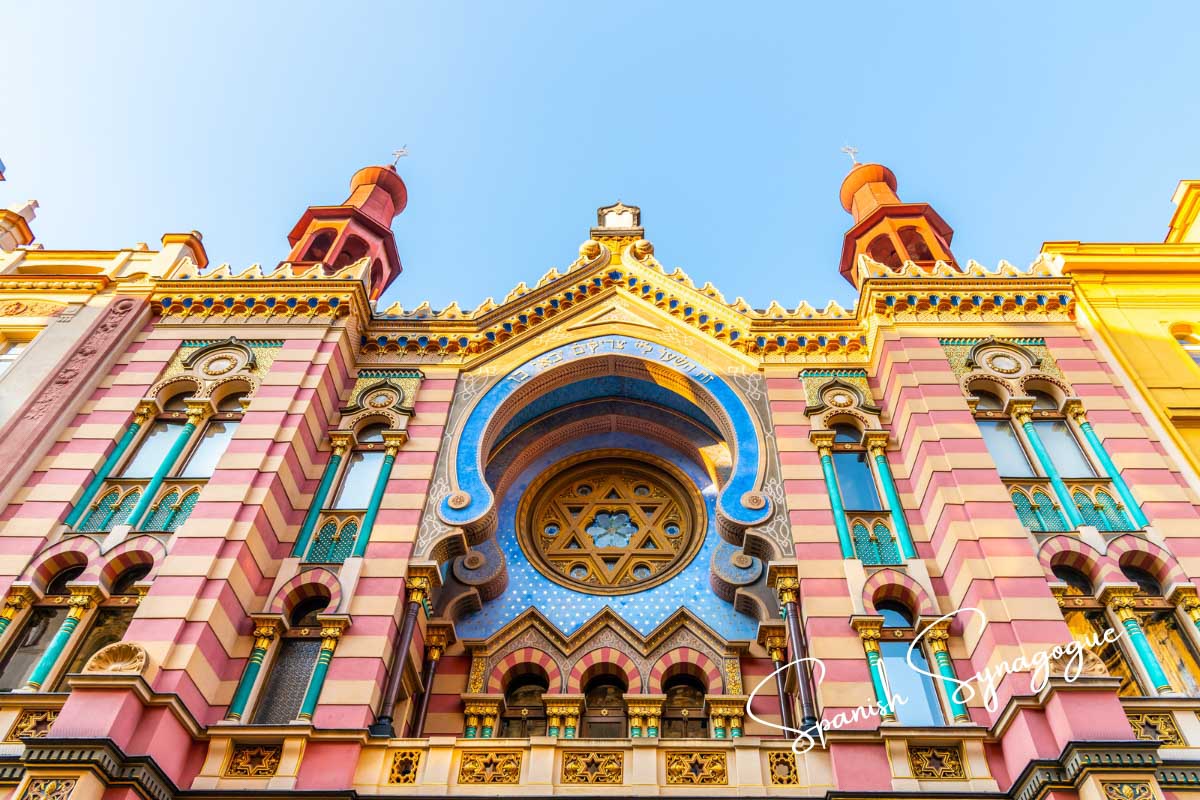
Similarly to the Prague Castle section, I haven’t included these synagogues and museums as separate listings in this post. Instead, I summarize the importance of each building and have placed the pins in the Prague walking tour map listed above.
Pinkas Synagogue is the second oldest synagogue in Prague from the 1500s and has been restored countless times over the centuries.
Old Jewish Cemetery is another must-visit Prague attraction because it is the oldest surviving Jewish burial ground in the city that dates back to the mid-15th century. Back then, the laws prohibited local Jews from burying the dead outside of the ghetto, which obviously resulted in cramped and overcrowded gravestones that are eerie, surreal, and mindblowing to see. Around 12,000 tombstones are visible, but about 100,000 bodies are estimated to be buried below them, stacked up to 12 ground layers.
Klausen Synagogue was established by Mordechai Maisel, a that-time Mayor of the Jewish Quarter, at the turn of the 17th century. It was constructed on the sight of the former Jewish school and a small prayer house.
The Old-New Synagogue is another noteworthy spot on this Prague walking tour, standing as the oldest surviving synagogue in Europe. The synagogue, built in approximately 1270, managed to endure many fires, Jewish massacres, destruction of the ghetto, and even the Nazi occupation.

Spanish Synagogue is the city’s newest Jewish religious building, constructed in 1868. The ornate facade, with its horseshoe arches, pseudo-minarets, and columns, is gorgeous to look at. Inside, the pseudo-Moorish design deliberately mirrors the Spanish Alhambra and contrasts with the other, simpler synagogues of the Quarter.
Maisel Synagogue, built in Neo-Gothic style, was constructed at the end of the 16th century as a private prayer house for the Mordechai Maisel family, who got wealthy by lending money to Emperor Rudolph II to aid the wars against the Turks. He used the profits to develop and invest in the Jewish Quarter.
Apparently, the original synagogue was the most ornate of them all and sadly, was destroyed by fire in 1689. It was then rebuilt to its current state at the beginning of the 20th century. Today, it houses an exhibition about the history of the Jewish community in the Czech Republic, documenting their lives here from the 10th to the 18th century.
The Quarter is now part of the Jewish Museum in Prague and requires entrance tickets to the synagogues, museums, and the cemetery.
- Opening hours: every day, except Saturdays and Jewish Holidays. More info.
- Entrance fee: adults – 500 CZK gives you access to all the Prague Jewish Town attractions and is valid for three days.
Recommended tours in Prague Jewish Quarter:
Kafka Monument
Franz Kafka, the famous novelist and short-story writer, was born in Prague, primarily in the Old Town and its Jewish Quarter, to a German-Jewish mother and a Czech-Jewish father.
Because of his German and Czech parents, he was rarely accepted in any of these nationality groups and often lived in isolation and fear, and most of his works were not published in his lifetime.
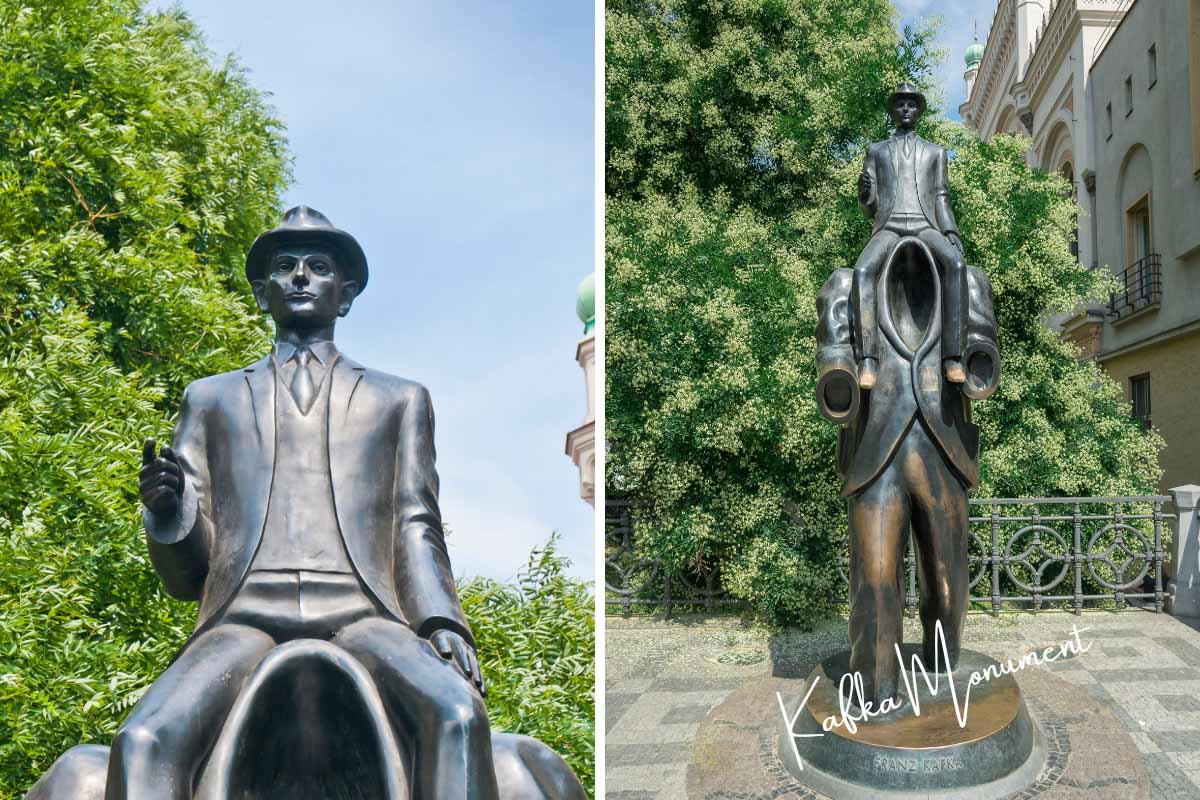
Ironically, as Kafka became world famous, now Prague has his face placed on mugs, magnets, postcards, T-shirts, and other souvenirs.
The monument honoring him, located a few minutes from the synagogues, is one of the most bizarre sculptures you might see in Prague. It shows Kafka sitting on the shoulders of a headless figure, probably Kafka himself, and references his story Description of a Struggle written in 1912.
Old Town Square
Following the fancy Parizska Street lined with luxury designer stores, you’ll return to Prague’s historic square.
Take some time now to wander around admiring beautiful pastel-colored buildings of different architectural styles, such as Art-Nouveau, Baroque, Gothic, Rococo, and Renaissance.
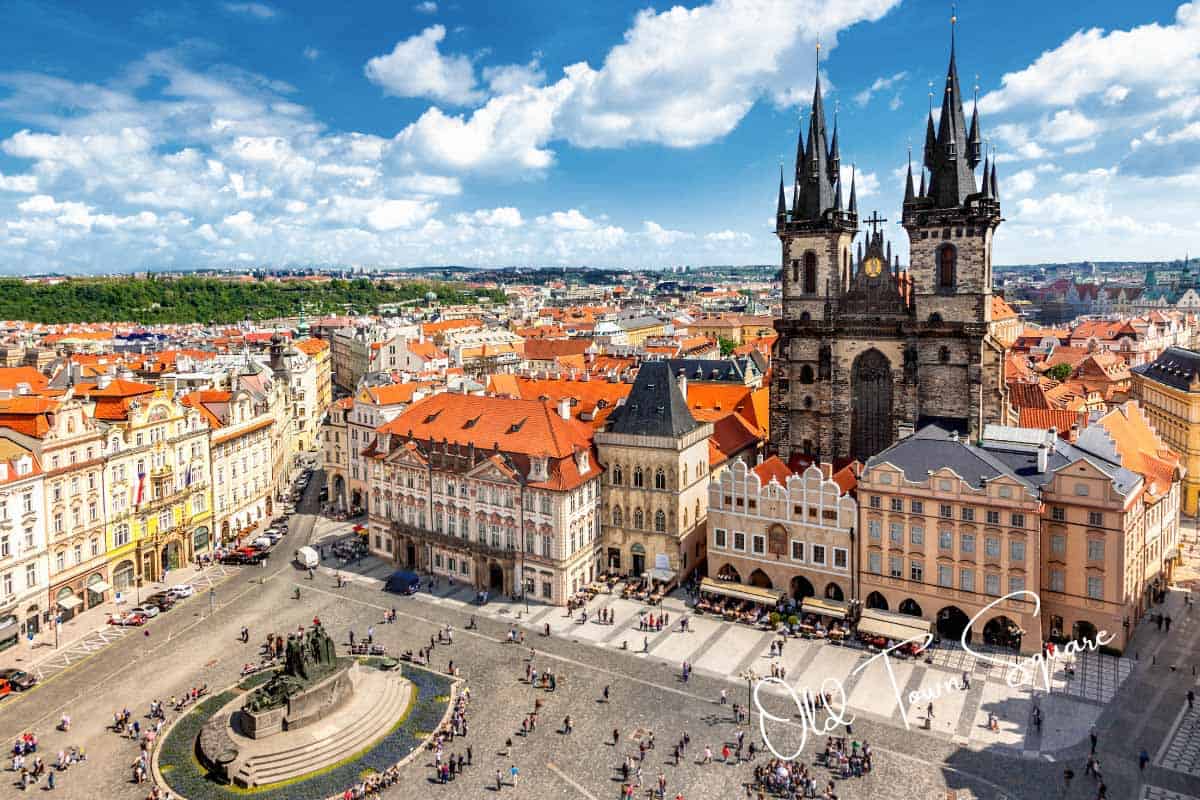
Storch House, at number 16 south of the square, also called House of the Stone Madonna, has one of the most stunning painted exteriors. The Kinský Palace on the east is another noteworthy building with a white and pink stuccoed Rococo facade that today houses the National Gallery’s exhibition.
Make sure to visit the Gothic Church of Our Lady before Týn that dominates the skyline of the Old Town Square. This 15th-century church has towers that shoot up 80 meters; if you look closely, you’ll see that these towers are not identical.
Besides historical buildings, the square is lined up with various museums, restaurants, and souvenir shops for you to pop in.
You must be hungry after that walk, right? Take a look at the must-visit restaurants for food lovers in Prague
Guided Prague walking tours
If you want to avoid the hassle of this tour and prefer to join guided walking tours in Prague to learn more about the history and culture of the city, here are a few recommended Prague walking tours:
A 3-Hour Walking Tour of Old Town & Prague Castle takes you from the historic Old Town to Prague Castle with professional local guides who tell interesting stories and legends.
Alternative Prague Walking Tour is great for those who prefer to see a different side of the city that passes through cool Prague neighborhoods, street art, and underground subcultures.

Prague Ghosts and Legends Walking Tour is an evening tour that lasts from 1:30 to 2 hours, where you walk through haunted streets and listen to mysterious stories of medieval Prague.
Old Town and Jewish Quarter Guided Walking Tour walks through the Jewish Quarter, where you can listen to the history of Prague’s Jewish community and see its synagogues and the cemetery.
Old Town, Medieval Underground & Dungeon Tour is ideal for those who’d love to see what is hidden below the Old Town with its rooms, cellars, and corridors.
Where to stay in Prague
Prague offers a variety of neighborhoods and areas to stay in, depending on your preferences and budget. Old Town and New Town offer plenty of accommodation options for a central location, ranging from budget hostels to luxury hotels. These areas provide easy access to many of the city’s top attractions, including the Charles Bridge and Old Town Square.
For a quieter stay, the Mala Strana and Vinohrady neighborhoods offer a more residential feel, with plenty of charming streets and local restaurants to explore. I have a dedicated post on where to stay in Prague that explains the neighborhoods and provides a list of some of the best hotels in Prague.
Best time to visit Prague
Prague is a beautiful city that offers visitors a rich history, stunning architecture, and a vibrant culture. However, the city’s weather can vary greatly depending on the season, making it essential to plan your trip accordingly.

The best time to visit Prague is during the spring and fall when the weather is mild and the crowds are smaller. The peak tourist season is summer, from June to August. The season is warm and sunny, bringing crowds of tourists, and hotel prices tend to go high.
Winter is magical and another best time to visit Prague, especially around the holidays when the city is decorated with Christmas markets and lights. However, the weather can be pretty cold, with temperatures ranging from -5 °C to 5°C, and there is a chance of snow. However, snow-covered Prague is absolutely stunning.
What to wear in Prague
Prague is a walkable city with cobblestone streets lining most of its central districts. Therefore, it is essential to know what to wear in Prague based on weather temperatures and the activities you plan to do.
The weather in Prague can vary greatly depending on the season, so it’s important to pack clothing appropriate for the time of year you plan to visit. If you plan to visit during summer, pack lightweight and breathable clothing, such as t-shirts, shorts, flowy skirts, and long dresses. However, bring a light foldable raincoat or umbrella for occasional rain showers.

Planning a trip for spring or autumn and want to know what to wear in Prague for those seasons? In that case, pack layers that will keep you warm during cooler mornings and evenings. A light coat or jacket, cardigan, or scarf can help you adjust to temperature changes throughout the day.
Winter in Prague is quite cold, and temperatures drop below freezing, so wear warm clothes like sweaters or hoodies and winter jacket. Remember a winter hat, scarf, and gloves. I typically opt for thermal leggings and t-shirts for winter travels that I wear underneath jeans and a hoodie.
Since the best way to explore Prague is by aimlessly wandering its streets, comfortable footwear is essential, regardless of season. Bring comfortable walking shoes or sneakers that can withstand long days of walking on cobblestone streets. I always pack my Teva walking shoes and/or The North Face sandals for warmer climates. Bring waterproof winter shoes to navigate through snow and ice if you plan to visit during winter.
Remember to throw in these useful accessories in your bag:
Camera or phone: Prague is extremely photogenic city, so be sure to bring a camera (I have Sony a6300) or smartphone (I recently purchased Google Pixel 7 Lemongrass color) to capture all the sights.
Power bank: I am sure you’ll be taking lots of photos and using maps to navigate around. Therefore, having an external charger to keep you on the go, is very important. I have this Anker power charger.
Universal adapter: If you are coming from outside Europe, you’ll need a universal adapter to be able to charge your devices.

What a great walking (and virtual for now) tour! I love how much you are able to take in in just 6km!!! I will definitely refer back to this if I even make it to Prague.
i would love to visit prague! very high on my bucket list and love this itinerary
Ahh! I can’t stand not knowing the story behind something, now I really want to know about Černý’s Upsidedown statue of St Wenceslas! In any case it’s very interesting and I guess we can all make our own decision about what Černý’s trying to say with it.
Thank you for including a map! This helps a ton when trying to find out where to start! Old Town looks amazing…
I have only heard amazing things about Prague, and I love how you fit in so many things in this day trip! I cannot believe how big Prague Castle is. I can’t imagine exploring a place so large! Seems like there is just so much to do here!
I visited Prague a very long time ago and I would love to go there again! This self walking tour is such a great idea! Super useful, I am saving it for later! Thank you Baia!
Same here, would love to go back sometime soon!
Prague is so lovely!! This is such a great walking guide. I would love to come back and be able to explore more.
Happy you found it useful! 🙂
Simply in love with the photography here- I am a sucker for architecture and Prague has a veritable dose of that.
Hey Shalzmojo, yes the city has gorgeous buildings to admire 🙂
Great post!! Its pretty elaborate and so helpful in anyone willing to take a self-guide walk. Love the pictures also 🙂
Thank you so much! I am glad you found it useful 🙂
I love this idea. There is a lot to see in Prague and it’s easy to miss things so this is so useful and very comprehensive
Definitely! Prague has plenty of things to see and it’s very easy to miss some of them
This is great! I actually recognise some of it from when I wandered around the city myself. It’s an amazing place to be.
What a great walking tour of Prague! I would especially enjoy wandering old town, taking tons of photos of the clock and Charles Bridge! It definitely seems that Prague has a ton of charm and sights to see. 😁
This will be such a handy guide next time I’m in Prague! You really mapped out for us, thanks!
Happy to provide all the details 🙂
I love Prague so much. Easily one of my favorite cities. This is great itinerary, and it gave me a nice walk down memory lane!
Love this! Prague is one of my favourite cities and I can’t wait to visit again one day 🙂 I was lucky to have my friend that lives there show me around when I stayed with her but would like to go back to a few of the spots that I missed!